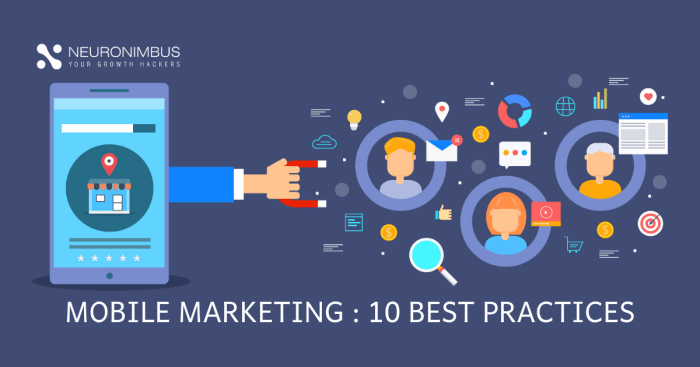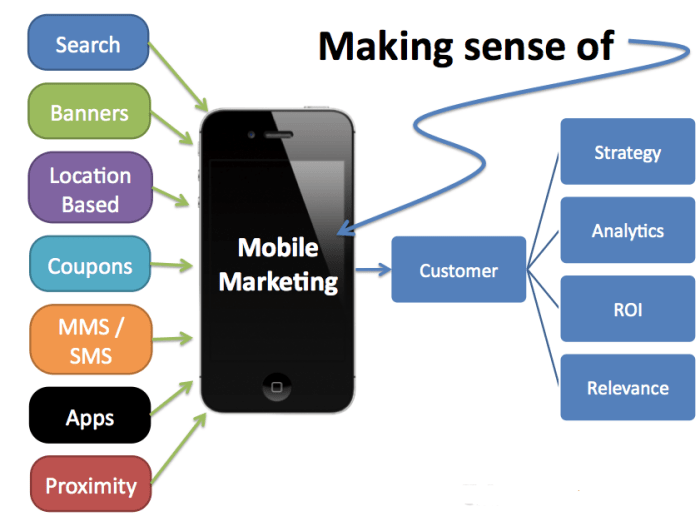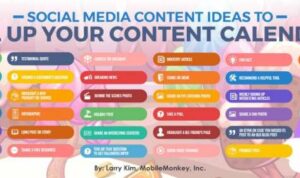Developing a Mobile Marketing Strategy sets the stage for navigating the dynamic landscape of digital advertising, where innovation and strategy converge to captivate audiences and drive results. Dive into a world where creativity meets analytics, and let’s explore the art of mobile marketing together.
In today’s fast-paced digital world, businesses need to adapt their marketing strategies to meet consumers on their smartphones. This guide will take you through the essentials of crafting a successful mobile marketing strategy that resonates with your target audience.
Introduction to Mobile Marketing Strategy
Mobile marketing has become a crucial aspect of any business strategy in today’s digital age. With the increasing use of smartphones and mobile devices, having a solid mobile marketing strategy is essential for reaching and engaging with customers.
Mobile marketing differs from traditional marketing in the sense that it specifically targets users on their mobile devices, utilizing features such as location-based services, push notifications, and mobile apps to deliver personalized and relevant content.
Mobile Usage Statistics and Impact
- Over 3.8 billion people worldwide use smartphones, making mobile marketing a powerful tool to reach a large audience.
- Mobile users spend an average of 3 hours and 15 minutes per day on their devices, providing ample opportunities for businesses to connect with them.
- Mobile searches have surpassed desktop searches, highlighting the importance of optimizing marketing strategies for mobile platforms.
- Mobile advertising spending is projected to reach $240 billion by 2022, indicating the significant impact of mobile marketing on overall advertising budgets.
Understanding your Target Audience

Identifying your target audience is crucial for the success of your mobile marketing strategy. By knowing who you are trying to reach, you can tailor your campaigns to their specific preferences and behaviors.
Significance of Identifying the Target Audience
Market research is key to understanding your audience’s preferences. Conduct surveys, analyze data, and use tools like Google Analytics to gather information about your target demographic. This will help you create personalized and targeted mobile marketing campaigns that resonate with your audience.
Conducting Market Research to Understand Audience Preferences
- Utilize social media analytics to track user engagement and behavior.
- Segment your audience based on demographics, interests, and behaviors.
- Monitor trends and consumer insights to stay up-to-date with your target audience’s preferences.
Examples of Successful Mobile Marketing Campaigns
- Starbucks’ mobile app offers personalized rewards and discounts based on user preferences and purchase history.
- Nike’s running app uses GPS tracking to provide customized workout plans for different fitness levels.
- Coca-Cola’s “Share a Coke” campaign allowed customers to personalize bottles with their names, creating a buzz on social media and driving sales.
Mobile-Friendly Website and App Development

Having a mobile-friendly website and app is crucial for a successful marketing strategy in today’s digital landscape. With the increasing use of smartphones and tablets, businesses need to ensure that their online presence is optimized for mobile devices to reach a wider audience and provide a seamless user experience.
Responsive Design and Mobile Optimization
Responsive design plays a key role in mobile optimization by allowing websites to adapt to different screen sizes and resolutions. This ensures that the content remains visually appealing and easy to navigate across various devices, whether it’s a smartphone, tablet, or desktop computer.
- Utilize flexible layouts and images that adjust based on the screen size.
- Implement fluid grids and media queries to create a responsive design that works on all devices.
- Optimize loading times by reducing image sizes and minimizing the use of large files that can slow down the site on mobile devices.
Tips for Creating a Seamless User Experience on Mobile Devices
Creating a seamless user experience on mobile devices involves more than just responsive design. It’s about understanding the unique behaviors and preferences of mobile users and tailoring your website and app to meet their needs.
- Keep navigation simple and intuitive, with clear calls-to-action that are easy to tap.
- Optimize forms for mobile by using auto-fill options and minimizing the number of fields required.
- Ensure fast load times by optimizing images, minimizing redirects, and leveraging caching techniques.
- Use mobile-friendly fonts and text sizes to ensure readability on smaller screens.
- Test your website and app on various devices and browsers to identify any issues and make necessary adjustments.
Utilizing Mobile Advertising Channels: Developing A Mobile Marketing Strategy
Mobile advertising channels are essential in reaching your target audience effectively in the digital age. Let’s explore the different options available and compare their effectiveness in engaging users.
Social Media Advertising
Social media platforms like Facebook, Instagram, and Twitter offer robust advertising options to target specific demographics based on interests, behavior, and location. With the ability to create engaging visual content and interactive ads, social media advertising can yield high engagement rates.
In-App Ads
Advertising within mobile apps provides a direct way to reach users while they are actively engaged with the content. Whether it’s banner ads, interstitials, or native ads, in-app advertising can be highly effective in driving conversions and brand awareness.
SMS Marketing
Text message marketing allows businesses to send targeted messages directly to users’ mobile phones. While it requires obtaining user consent, SMS marketing boasts high open rates and can be a powerful tool for promotions, reminders, and personalized communication.
Examples of Successful Mobile Advertising Campaigns
One notable example is Airbnb’s Instagram Stories campaign, where they showcased unique stays and experiences through captivating visuals and interactive features. Another success story is Dunkin’ Donuts’ Waze advertising campaign, which utilized location-based targeting to drive foot traffic to nearby stores.
Personalization and Location-Based Marketing
Personalization and location-based marketing are two key strategies in mobile marketing that can greatly enhance the effectiveness of your campaigns.
Benefits of Personalizing Mobile Marketing Messages
- Increased engagement: By tailoring messages to the individual preferences and behaviors of your target audience, you can capture their attention more effectively.
- Improved conversion rates: Personalized messages are more likely to resonate with consumers, leading to higher conversion rates and sales.
- Enhanced brand loyalty: When customers feel like you understand their needs and preferences, they are more likely to develop a sense of loyalty towards your brand.
Role of Location-Based Marketing
- Precision targeting: Location-based marketing allows you to target consumers based on their geographical location, ensuring that your messages are relevant and timely.
- Increased foot traffic: By sending location-specific offers or promotions, you can drive foot traffic to your physical store locations.
- Enhanced customer experience: Providing location-based information such as store directions or nearby deals can enhance the overall customer experience.
Best Practices for Implementing Personalization and Location-Based Strategies
- Collect and analyze data: Gather relevant data about your target audience to create personalized messages and identify location-based opportunities.
- Use geofencing technology: Implement geofencing to target consumers in specific geographic areas with relevant offers or messages.
- Test and optimize: Continuously test and optimize your personalization and location-based campaigns to ensure maximum effectiveness.
Mobile Marketing Analytics and Measurement
In the world of mobile marketing, tracking and analyzing data is crucial for understanding the effectiveness of your campaigns. By measuring key metrics and using the right tools, you can make informed decisions to optimize your strategies for better results.
Importance of Tracking and Analyzing Data, Developing a Mobile Marketing Strategy
Mobile marketing analytics allows you to gather insights into user behavior, engagement, and conversion rates. By monitoring data, you can identify trends, measure the impact of your campaigns, and make data-driven decisions to improve your mobile marketing efforts.
Key Metrics to Monitor
- App Installs: Measure the number of downloads and installations of your mobile app to gauge its popularity.
- Engagement Rate: Track user interactions such as clicks, views, and time spent on your mobile site or app.
- Conversion Rate: Monitor the percentage of users who complete a desired action, such as making a purchase or signing up for a newsletter.
- Retention Rate: Measure how many users continue to engage with your app over time.
Tools and Techniques for Measurement
- Google Analytics: A powerful tool for tracking and analyzing website and app performance, providing valuable insights into user behavior.
- Mobile App Analytics: Platforms like Firebase and Flurry offer in-depth data on app usage, user demographics, and more.
- A/B Testing: Compare different versions of your mobile marketing campaigns to see which performs better and make data-driven optimizations.
- Attribution Modeling: Determine which marketing channels are driving conversions and allocate your budget effectively based on performance.












